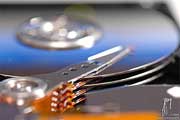 There are many types of storage devices such as floppy disks, CDs, DVDs, memory cards, and USB flash drives. However, for computers, the most critical storage device remains the HDD (Hard Disk Drive). Over time, hard drives have increased in capacity while their prices have tended to decrease.
There are many types of storage devices such as floppy disks, CDs, DVDs, memory cards, and USB flash drives. However, for computers, the most critical storage device remains the HDD (Hard Disk Drive). Over time, hard drives have increased in capacity while their prices have tended to decrease.
About five years ago, common hard drives had capacities ranging from 1.2 GB to a maximum of 10 GB. Now, hard drives come with capacities of 40 GB, 80 GB, and even hundreds of GB.
However, the most invaluable aspect is the data contained within the hard drive. A day could come when the drive unexpectedly “dies” before you have a chance to back up your data, and that would be a disaster. Therefore, it is essential to monitor the health of this crucial storage device to respond promptly.
A critical standard that manufacturers must integrate into hard drives to instill confidence in consumers is S.M.A.R.T (Self-Monitoring Analysis and Reporting Technology). This technology helps detect signs of impending failure that could cause the hard drive to stop functioning. When potential issues are identified, this feature will issue warnings to users. S.M.A.R.T was developed based on Predictive Failure Analysis (PFA) techniques by IBM, initially applied to Mainframe Computers used in military and industrial settings. The first company to research this technology for desktop computers was Compaq, under the name Drive Failure Prediction. Notably, IBM tested over 3 million different hard drives to establish the standards for S.M.A.R.T.
If you have activated the S.M.A.R.T feature in the motherboard BIOS setup, and if the hard drive is about to fail, you may receive a notification stating “HDD Bad, Backup and Replace“.
S.M.A.R.T Technology
This includes about 35 different attributes that help detect around 70% of errors in hard drives. Users are informed through the BIOS screen or diagnostic software. Each manufacturer may integrate different attributes into their products, but the ultimate goal is to predict potential dangerous failures, estimating the time of occurrence so users can back up their data in time. Some common attributes integrated by hard drive manufacturers in S.M.A.R.T technology include monitoring the temperature of the hard drive, rotational speed, occurrences of errors, and counting the number of times the device has been powered on and off.
Diagnostic Software
– HDD Health V 2.1: Created by Aleksey S Cherkasskiy, this software is 879KB in size and can be downloaded from www.panterasoft.com. It analyzes 15 technical attributes. The most important feature is that when you click on the Health tab, if the Known Problems box shows: “There are no problems with this hard drive“, you can feel relatively assured. If both the Overall health status and the Nearest T.E.C boxes are marked N/A, your hard drive is likely in very good condition, and there is no need to worry.
– D-Temp: This lightweight software is 144KB, free, and requires no installation; it runs with just a click and displays the current temperature of the hard drive in the system tray. You can download it from http://private.peterlink.ru/tochinov/download.html.
– HDD Thermometer: This software monitors the temperature of the hard drive, is 213KB in size, and is free but requires registration to use (no payment is necessary). If you haven’t registered, you will encounter a nag screen every time you run the program. This software is quite reliable for temperature monitoring and also displays the hard drive temperature in the system tray. Created by Georgy Koychev, it can be downloaded from www.rsdsoft.com.
Tạ Xuân Quan
















































